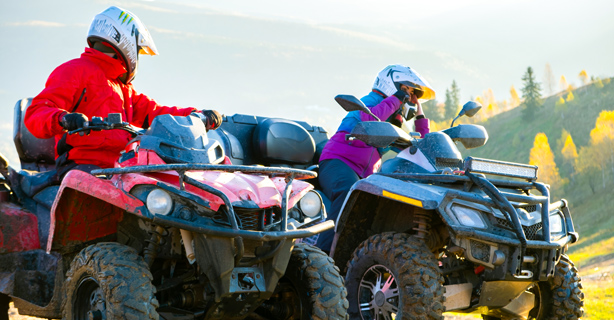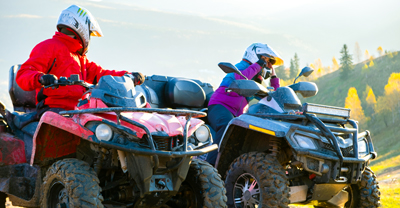A guide to ATV/UTV safety gear


0 min. read
Even the most experienced off-road riders take safety seriously. After all, on any ATV or UTV ride, you can encounter unfamiliar terrain, sharp corners, kicked-up rocks and debris, and even reckless riders. Plus, the way these vehicles are designed leaves you exposed to the world around you. Review the list below to make sure you’re protected next time you ride off-road.
What protective gear is needed to ride an ATV/UTV?
The right ATV safety gear can significantly reduce your risk of injury. Here are the basics every rider should wear:
Helmets for off-road vehicles

Wearing a helmet is non-negotiable. In fact, many states enforce helmet laws—especially for minors and riders on public land. A helmet is the single most important piece of off-road safety gear. Helmets protect your head from impacts, which can be lifesaving in an accident. Make sure your helmet:
Fits your head snugly
Has adequate ventilation
Is comfortable for long periods
Meets or exceeds safety standards
Is certified by an agency such as the DOT, ECE, or Snell.
Goggles for ATV riding

If you’re not wearing a full-face helmet, you need other eye protection. Goggles help protect your eyes from debris and dust and keep your vision clear by blocking out precipitation and insects. Choose goggles with anti-fog features and UV protection for the best visibility and safety.
Gloves for off-road riding

Gloves give you a good grip so you can maintain better control over your vehicle. A good pair of gloves also protects your hands from scratches, burns, and other injuries. Look for gloves made from leather or synthetic materials with reinforced padding.

What clothing should I wear when riding an ATV/UTV?
Wear clothing that is appropriate for the weather and season—overheating or getting too cold can affect your focus and limit your ability to control your vehicle. Moisture-wicking materials can also help keep you comfortable.
More than that, protective clothing can help prevent serious injuries by providing extra durability and covering exposed skin. Here's where to start:
Off-road vehicle (ORV) jackets and jerseys

A good jacket or long-sleeve jersey can help protect you from the elements and potential injuries. Look for jackets made of durable materials like leather or synthetic fabrics that offer abrasion resistance.
Off-road riding pants

Pants specifically designed for off-roading can help protect against leg injuries like road rash. Look for pants made from tough materials that can withstand abrasions, impacts, and punctures, with reinforced knees and padding for extra protection.
Boots for off-roading

High-quality boots protect your feet and ankles, providing stability and support. Choose boots specifically designed for ATV riding, which offer better protection and comfort than standard work boots or tennis shoes.
Additional protective ATV/UTV gear
Beyond these basics, you can enhance your safety with:
Neck brace

A brace can help prevent serious injury by stabilizing your neck, which can reduce spinal injury risk in an impact. Choose a neck brace that fits based on the manufacturer’s guidelines and will also fit inside your helmet and still be comfortable.
Chest protector

An ATV-specific chest protector shields your torso and vital organs from any road debris or accidental impacts and can minimize the severity of potential injuries. A chest protector should fit you snugly but not restrict your movements.
Knee and elbow pads

Pads can cushion your joints from injuries during a fall or collision. Like chest protectors, knee/elbow pads should fit well but not restrict your movement.
What not to wear on an ATV/UTV
You have a range of options when it comes to protective clothing and gear for off-roading. But some things should not be worn on an ATV/UTV, including:
Sandals, flip flops, and slip-on shoes
Shorts
Tank tops
Loose or dangling clothing
Jewelry
Belts

ATV/UTV safety tips
Safety gear is important but can’t make up for unsafe riding practices. Keep safety a priority at every step in your off-road adventures. For more, read our 8 safety tips to know before the next time you drive your ATV.
Pre-ride ORV inspections
Always inspect your ATV pre-ride to make sure it's in good working condition. Before you head for the next trail:
Check your ATV's tire pressure, tread wear, and overall tire condition
Inspect your brakes
Check that your throttle cable is in working order
Ensure all lights function properly
Verify fuel, oil, and other fluid levels
If this is your first or last ride of the season, change the oil and swap out any old fuel for new.
Safe riding techniques
If your community offers ATV/UTV safety classes, consider signing up. In these classes, you'll learn proper riding guidelines, including:
Maintaining correct posture while riding, centering your weight over the ORV
Using both brakes for controlled stops
Avoiding sudden movements and high speeds on unfamiliar terrains
Emergency preparedness
Even with the right safety gear and advance planning, ORV accidents still happen. Before your trip, let someone know where you’re going and when you expect to be back.
When you’re out on the trail, be sure to have:
A first-aid kit
A tool kit for minor repairs
A mobile phone
GPS access in case you lose cell service
If you do run into trouble, stay calm and assess the situation. If anyone’s hurt, use your first-aid kit for minor injuries and call the local emergency response services if anyone is seriously injured.
Dairyland has your back out on the trails
Investing in quality ATV safety gear is essential for a safe and enjoyable riding experience. If you need insurance coverage for your ATV or UTV, reach out to Dairyland today and get a quote.
The general information in this blog is for informational or entertainment purposes only. View our blog disclaimer.










